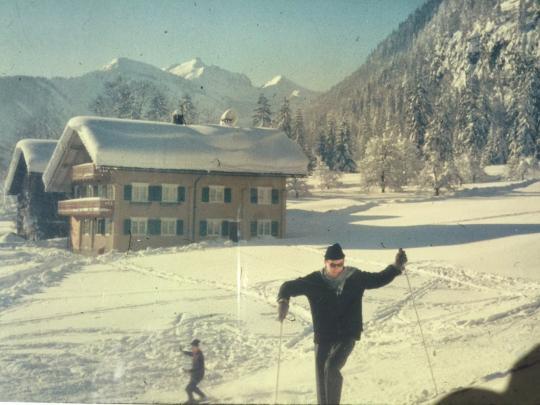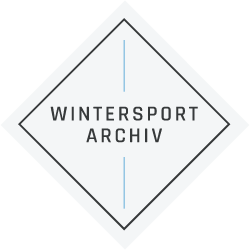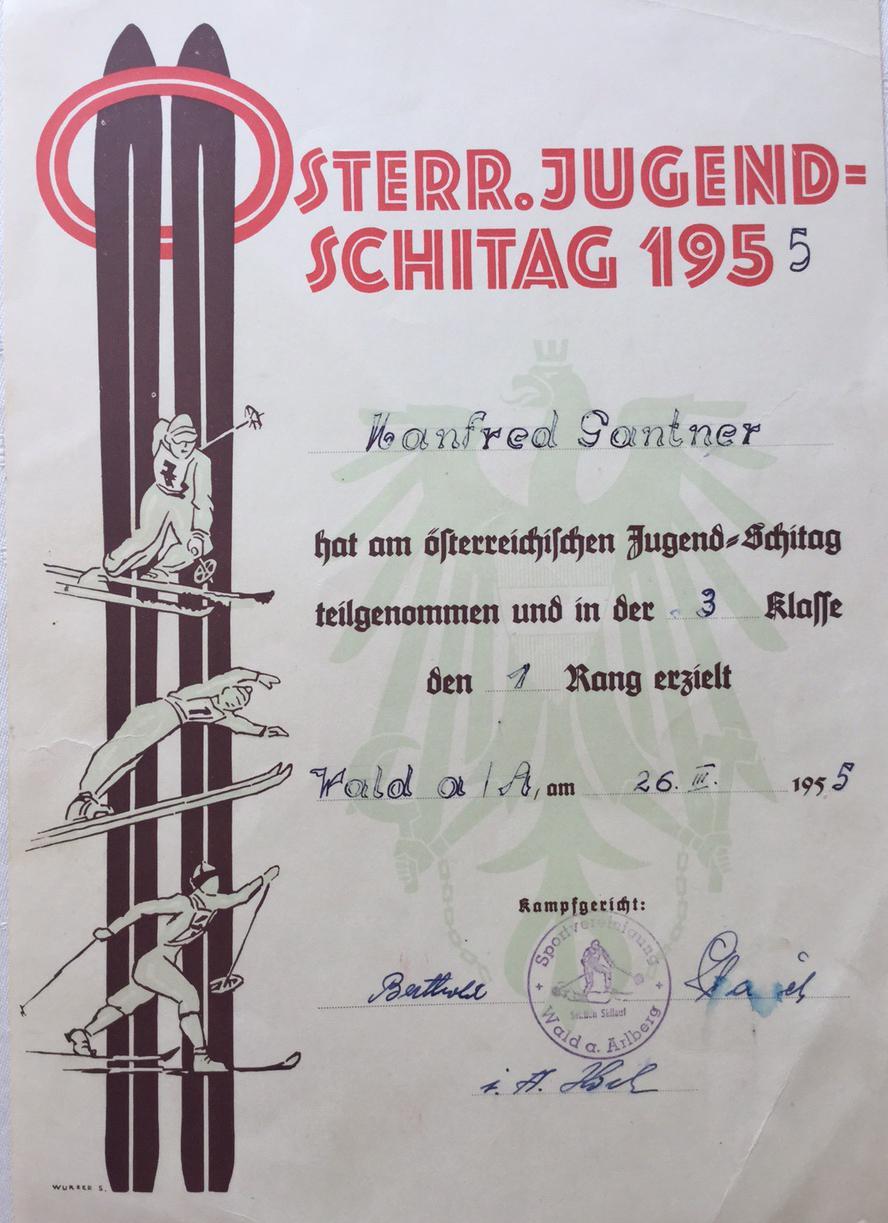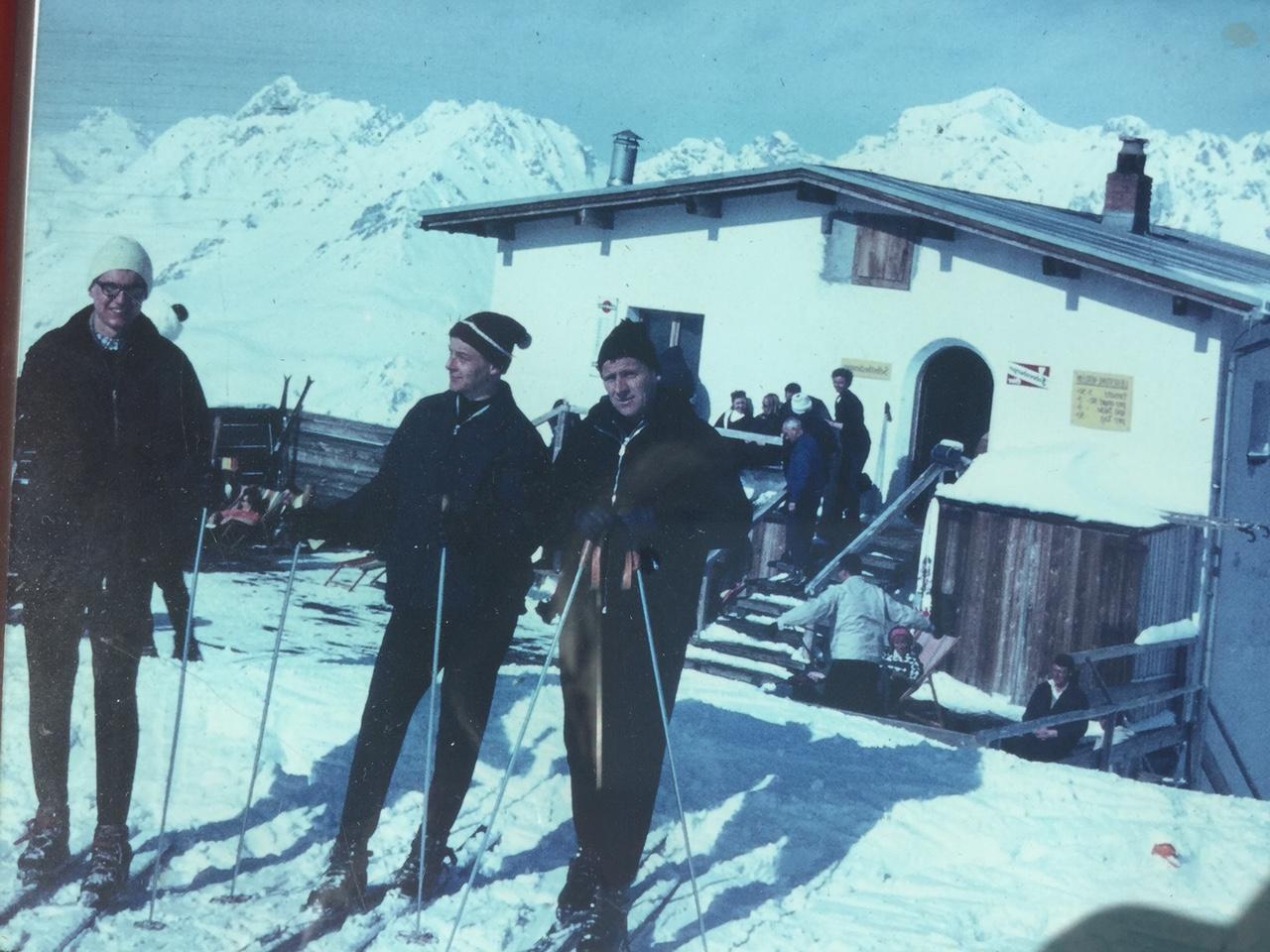Winter sport stories from the Klostertal
Manfried Gantner from Dalaas im Klostertal reminisces about his earlier attempts at skiing and his memories of winter sports in the Klostertal.
My first attempts at skiing were in the winter of 1949/50, when I was a boy of less than 5 years old. They took place behind the house on the main road to which we had moved in December 1949. From the late fifties this was also the location of the “Pension Radona”, run by my mother, Gisela Gantner (nee Beck). Together with a neighbouring building (storehouse) the house was the headquarters of the building company which my father, the master mason Leo Gantner, had founded in 1938. Behind this house (prior to the improvement works which were carried out much later) was a series of humps and bumps of perhaps 3 metres in height, (but which to me as a child were mountains of considerable challenge), plus a smaller, gentler incline. Quite enough of a slope for my first ski attempts.
But the Schloßbühel (Castle hill) together with my cousin Georg Gantner and several other “Goga” (kids) presented an altogether greater challenge and nerve. The easiest run was from the Schloßbühel down towards Johann Gantner’s house, in a westerly direction. As Georg and I became increasingly bolder, we tackled the slope to the south, towards today’s Klostertaler Folklore Museum. It was considerably steeper, and at the bottom were two or three fruit trees between which you had to try and schuss. At the back of the hill, towards the railway, the transition from steep slope to valley floor was much too abrupt to schuss. As far as I can remember that was something we never dared. But in an easterly direction, towards the church, we came up with something else: You schussed the first bit, down from the railway passage, and then whizzed up the small slope opposite where you could execute a jump – smaller or larger depending on your speed. After that a long left swing took you down over the stream and back onto the valley floor. On occasions we also skied down the west side of the Ställiguat and the Avanzini barn from underneath the railway tracks. With the school we practised mostly behind the church: by the time the whole class had got up to the top and back down to the bottom, the afternoon school hours were already over.
In later years we built a ski jump for more adventurous jumping “auf Schattenhalb” on the meadow to the west of Hermann Leu’s barn and, after some practice runs, skied down past Haus Fritschy to the Alfenz on a slope that nowadays is completely covered in trees. The procedure was always the same: we side-stepped up and prepared a piste, of sorts which even included a series of curves.
So what was the equipment like in those days? At the beginning we had “unnamed skis”, which were unmarked children’s skis without edges, probably made from ash, incorporating cable bindings with leather straps. You stood your lace-up boots onto the binding, which was positioned along the ski beneath, and could be closed by means of a clasp. Once I painted my skis with a fresh coat of red laquer and then dried them in the warm bathroom, a procedure which, in spite of the intense chemical smell of nail polish, the family accepted without a murmur. Later on of course we were all desperate to get hold of Kästle skis from Hohenems (which subsequently featured universally in slalom, giant slalom and downhill racing events). These skis had edges, sported metal tip protectors and were constructed from several layers of wood. At some stage the “safety binding” arrived. This was a triangular metal affair which caused the front part of the boot to be released sideways in the event of a heavy blow or a fall (sometimes unintentionally!) The skis had safety cords to prevent the skis from heading off down the mountain on their own. The choice of skis on offer at that time was growing constantly, and included Kneissl, Kufstein-Tirol (with the renowned “Whitestar”), Fischer (Upper Austria) and Atomic (Salzburg). Technology marched on: from using glued-together layers of wood, it progressed to aluminium and further to composite materials. The edges were integrated and no longer screwed onto the skis. Intitially the only skis available were Austrian, and these got longer and loonger. (The longest skis I had when I was in my twenties were 2.20 m aluminium ones from Fischer. I never really got on with these because they were too rigid.)
The first ski poles were wooden (bamboo?) and each had a large basket made of willow. Later on these were superceded by metal poles with smaller plastic baskets. Functional clothing was non-existent, although we did have knitted gloves, which quickly got cold, then soaked through and finally froze solid if you had to root around in the snow too much. We also had trousers (the better ones were called “stretch trousers”) and jumpers as well as windproof jackets (anoraks). These were all supplied on a yearly basis and in ever-increasing sizes by Father Christmas.
Wald am Arlberg also had a ski club. At the time this was more of an Innerwaldner and thus an “ÖBB (railway) workers’” affair, meaning that the political tendencies verged towards the red side (SPÖ) of the political spectrum. I have a vague recollection of my father having some kind of official role in this club, although I never ever saw him skiing. In general the predominantly “black” or right wing inhabitants of Außerwald were not heavily represented in the ski club. (This situation should always be viewed with lighthearted humour and a knowing wink: there was a kind of Don Camillo-Pepone situation prevalent in the village, naturally without an active boss). Another problem was that we, as children and teenagers, had to attend morning Mass every Sunday followed at 14.00 by Vespers and the rosary, the latter of which conflicted timewise with ski activities. Once or twice I took part in the Wald am Arlberg Ski Club ski championships, which took place in Danöfen. The adults started from somewhere below the Purtschakopf, and had to first climb the mountain with skins on their skis. We younger competitors were allowed to start at the edge of the forest above the hay barns. Anyway, I took advantage of my memories of this event by digging out the diploma which proves that I participated in the Austrian Youth Ski Day of 1955.
Ski lifts didn’t arrive until the end of the 1950s, with the notable exception of the Arlberg area. This presented two problems for us youngsters: firstly, we had to get there and secondly, we had to buy a lift pass.
Suddenly (1956 or 1957?) the Paluda drag lift appeared in Dalaas. The ski runs were never prepared, with the exception of a couple of shovelfuls of snow that someone had chucked onto a bald patch of snow. It was at about the same time, around 1960, that Karl Brändle, the then mayor (village king) of Stuben and Klösterle, and hotelier in Langen a/A and Stuben, built the Albona lift. Of course, in the early days the ski runs here were not prepared either – they lacked the means to do so. This made the challenges and our enjoyment – especially after a heavy snowfall - even greater. (The Sonnenkopf lift was established much later, largely on the initiative of the mayor of Klösterle’s equally assertive follower, Erich Brunner, who was also the manager of the lift.)
In Zürs am Arlberg at that time there was a beginners’ lift between the two hotels, the Zürsersee drag lift, which was built around the end of the 1930s (supposedly the first drag lift in Austria) and lastly the Hexenboden lift, another drag lift. On one Carnival Sunday during this period I can remember the Hexenboden lift being populated almost exclusively by masked skiers, many of them witches with broomsticks instead of ski poles - a really colourful and evocative picture.
At that time Lech had the “Bürgermeister lift” below the Schwarzen Wand behind the church, the Schlegelkopf lift, which was a drag lift, and also a chairlift on the Kriegerhorn. On certain weekends in winter Finy Jochum, the secretary of our building company, used to take me to her home village of Lech am Arlberg, and in later years I was allowed to accompany our hotel guests. As a result I got to know and appreciate these lifts from an early age.
It goes without saying that back then we also went ski touring. Approaching the Maroiköpfe behind the Albonabahn lift was a joy. The climb up the Kaltenberg, however, was a real challenge, due mainly to the long opposing slope on the way back. To compensate, however, we were rewarded with a lovely long descent past the Kaltenberg hut to Langen a/A.
(Later, as a student in the years 1965 – 1968 I had a holiday job as an assistant instructor in the Lech am Arlberg ski school. Naturally I had to learn all the relevant English phrases, and did all I could to help the pupils in my care. One day during the lunch break I took the opportunity to ski a round of the “White Ring” (Lech -> Rüfikopf -> Zürs –> Madloch –> Lech). As a “ski instructor” I was entitled to use the dedicated entrance gate and jump the queue. At the time I was sporting a pair of the first mass-produced “clip boots” from Sporthaus Strolz in Lech and an equally overpriced red “McGregory” anorak with fur-lined pockets – all prime examples of juvenile consumer madness, long before the onset (much later!) of old-age meanness.)
At this time, during the 1950s, there was still no television, although we did have the radio. Naturally there were daily commentaries from the 1952 Winter Olympics in Oslo, where Trude Jochum-Beiser from Lech am Alberg, of whom everyone was very proud, was the much-acclaimed champion. The subsequent ski champions of our youth were of course Toni Sailer in 1956 (Cortina d’ Ampezzo) and his team mates from Kitzbühel, Ernst Hinterseer and Anderl Molterer (a real slalom talent with white blond hair). Later on we turned our admirating eyes to Karl Schranz from Lech, the ski star Gerhard Nenning, and the downhill champion on the Patscherkofel during the 1964 Winter Olympics, Egon Zimmermann. The racer from Zürs, Marianne Jahn (subsequently Nutt) also made a big impression on us at the time: I saw her once, training on the Steinhang below the top section of the Albona lift, and I could have watched her all day. Compared to her we all skied like beginners.
Later on, during the period 1956 – 1964, when I was attending the Jesuiten “Stella Matutina” secondary school, our annual “Stella Race” was held on Shrove Tuesday on the Paluda in Dalaas. This gave me a certain local advantage, although even so I can’t remember ever winning the title of “Stella Champion”. I do know that each year I had to compete against the small but extremely wiry Karl Gabl from St. Anton. Karl Gabl later became a well-known “weather man” with the ORF (Austrian broadcasting authority) and the Central Institute for Meteorology, and was responsible for the establishment of the external weather station at Innsbruck Airport. From his extremely readable memoirs (Karl Gabl, “Ich habe die Wolken von oben und unten gesehen” (“I’ve seen the clouds from above and below”, Tyrolia Verlag Innsbruck- Vienna 2016) I see from S. 38f., that he had been “Stella Champion on a number of occasions”. I had continued to meet up with my friend Karl in Innsbruck, and I was happy to hear about his racing triumphs.
Naturally the 1950s and 1960s saw the start of an enormous rise in winter tourism on the Arlberg, and this also had an economic and social influence on the Klostertal, particularly on the construction industry and on young people’s career choices. One illustration was the traffic situation during Carnival week, with its associated hold-ups and traffic jams on the main road leading up to the Arberg. If, for example on Good Friday, with the typical “Good Friday weather”, the Flexen Pass road was closed to boot, with Lech and Zürs resultantly “cut off”, then a desperate search for accommodation began, creating a knock-on effect right down to the area around Feldkirch and Dornbirn. I personally cannot see the increase in tourism in quite such a rosy light, because whenever I had school holidays, at Christmas, Easter and in the summer months, and was allowed home from boarding school, our house was always full of “foreigners” (guests), and the whole family was tied up looking after them. Of couse, my parents, my two sisters and I were very happy to have this additional source of income, and all beavered away together to help. Anyway, there were lots of really nice, interesting regulars among the guests, some of whom even took me skiing with them up to Lech and Zürs.
To summarise, the 1950s and 1960s were very much the formative years for winter sports in the Klostertal and on the Arlberg: the vast growth of accommodation capacity in guest houses and hotels; the development of roads and the establishment of lifts and cable cars; the traffic increase… at that time there seemed to be no limits to the growth explosion. And naturally, everyone had to learn to ski – that was an absolutely essential part of the cultural trend if you wanted to socialise with other young people in the winter months.
Author: Manfreid Gantner
Association of Klostertal Museums



